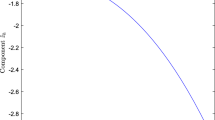Abstract
A general class of two-point boundary value problems involving Caputo fractional-order derivatives is considered. Such problems have been solved numerically in recent papers by Pedas and Tamme, and by Kopteva and Stynes, by transforming them to integral equations then solving these by piecewise-polynomial collocation. Here a general theory for this approach is developed, which encompasses the use of a variety of transformations to Volterra integral equations of the second kind. These integral equations have kernels comprising a sum of weakly singular terms; the general structure of solutions to such problems is analysed fully. Then a piecewise-polynomial collocation method for their solution is investigated and its convergence properties are derived, for both the basic collocation method and its iterated variant. From these results, an optimal choice can be made for the transformation to use in any given problem. Numerical results show that our theoretical convergence bounds are often sharp.
Similar content being viewed by others
References
Brunner, H.: Collocation Methods for Volterra Integral and Related Functional Differential Equations, Cambridge Monographs on Applied and Computational Mathematics, vol. 15. Cambridge University Press, Cambridge (2004). https://doi.org/10.1017/CBO9780511543234
Chen, S., Shen, J., Wang, L.L.: Generalized Jacobi functions and their applications to fractional differential equations. Math. Comput. 85(300), 1603–1638 (2016). https://doi.org/10.1090/mcom3035
Debnath, L.: Recent applications of fractional calculus to science and engineering. Int. J. Math. Math. Sci. 54, 3413–3442 (2003). https://doi.org/10.1155/S0161171203301486
Diethelm, K.: The Analysis of Fractional Differential Equations. Lecture Notes in Mathematics, vol. 2004. Springer, Berlin (2010)
Gautschi, W.: Some elementary inequalities relating to the gamma and incomplete gamma function. J. Math. Phys. 38, 77–81 (1959/60)
Kilbas, A.A., Srivastava, H.M., Trujillo, J.J.: Theory and Applications of Fractional Differential Equations. North-Holland Mathematics Studies, vol. 204. Elsevier Science B.V, Amsterdam (2006)
Kopteva, N., Stynes, M.: An efficient collocation method for a Caputo two-point boundary value problem. BIT 55(4), 1105–1123 (2015). https://doi.org/10.1007/s10543-014-0539-4
Kopteva, N., Stynes, M.: Analysis and numerical solution of a Riemann–Liouville fractional derivative two-point boundary value problem. Adv. Comput. Math. 43(1), 77–99 (2017). https://doi.org/10.1007/s10444-016-9476-x
Liang, H., Stynes, M.: Collocation methods for general Riemann–Liouville two-point boundary value problems (in preparation)
Machado, J.T., Kiryakova, V., Mainardi, F.: Recent history of fractional calculus. Commun. Nonlinear Sci. Numer. Simul. 16(3), 1140–1153 (2011). https://doi.org/10.1016/j.cnsns.2010.05.027
Monje, C.A., Chen, Y., Vinagre, B.M., Xue, D., Feliu, V.: Fractional-Order Systems and Controls. Advances in Industrial Control. Fundamentals and Applications. Springer, London (2010). https://doi.org/10.1007/978-1-84996-335-0
Pedas, A., Tamme, E.: Spline collocation methods for linear multi-term fractional differential equations. J. Comput. Appl. Math. 236(2), 167–176 (2011). https://doi.org/10.1016/j.cam.2011.06.015
Pedas, A., Tamme, E.: Piecewise polynomial collocation for linear boundary value problems of fractional differential equations. J. Comput. Appl. Math. 236(13), 3349–3359 (2012). https://doi.org/10.1016/j.cam.2012.03.002
Podlubny, I.: Fractional Differential Equations, Mathematics in Science and Engineering. An Introduction to Fractional Derivatives, Fractional Differential Equations, to Methods of Their Solution and Some of Their Applications, vol. 198. Academic Press Inc, San Diego, CA (1999)
Stynes, M.: A Caputo two-point boundary value problem: existence, uniqueness and regularity of a solution. Model. Anal. Inf. Sist. 23(3), 370–376 (2016)
Stynes, M.: Too much regularity may force too much uniqueness. Fract. Calc. Appl. Anal. 19(6), 1554–1562 (2016). https://doi.org/10.1515/fca-2016-0080
Stynes, M., Gracia, J.L.: A finite difference method for a two-point boundary value problem with a Caputo fractional derivative. IMA J. Numer. Anal. 35(2), 698–721 (2015). https://doi.org/10.1093/imanum/dru011
Vainikko, G.: Which functions are fractionally differentiable? Z. Anal. Anwend. 35(4), 465–487 (2016). https://doi.org/10.4171/ZAA/1574
Author information
Authors and Affiliations
Corresponding author
Additional information
The research of the first author is supported in part by the National Natural Science Foundation of China under Grants 11771128 and 11101130, and the University Nursing Program for Young Scholars with Creative Talents in Heilongjiang Province (No. UNPYSCT-2016020). The research of the second author is supported in part by the National Natural Science Foundation of China under Grants 91430216 and NSAF U1530401.
Rights and permissions
About this article
Cite this article
Liang, H., Stynes, M. Collocation Methods for General Caputo Two-Point Boundary Value Problems. J Sci Comput 76, 390–425 (2018). https://doi.org/10.1007/s10915-017-0622-5
Received:
Revised:
Accepted:
Published:
Issue Date:
DOI: https://doi.org/10.1007/s10915-017-0622-5




